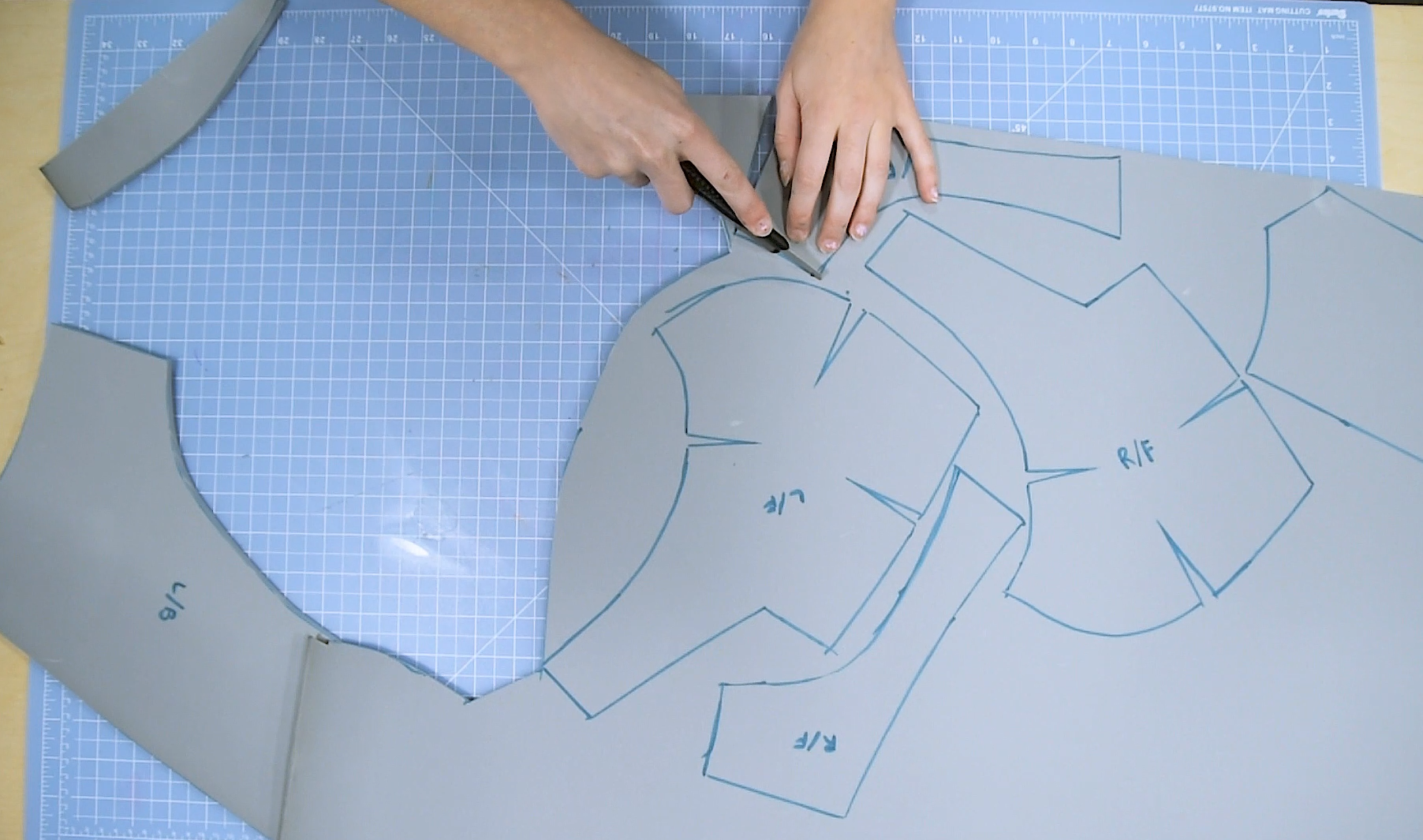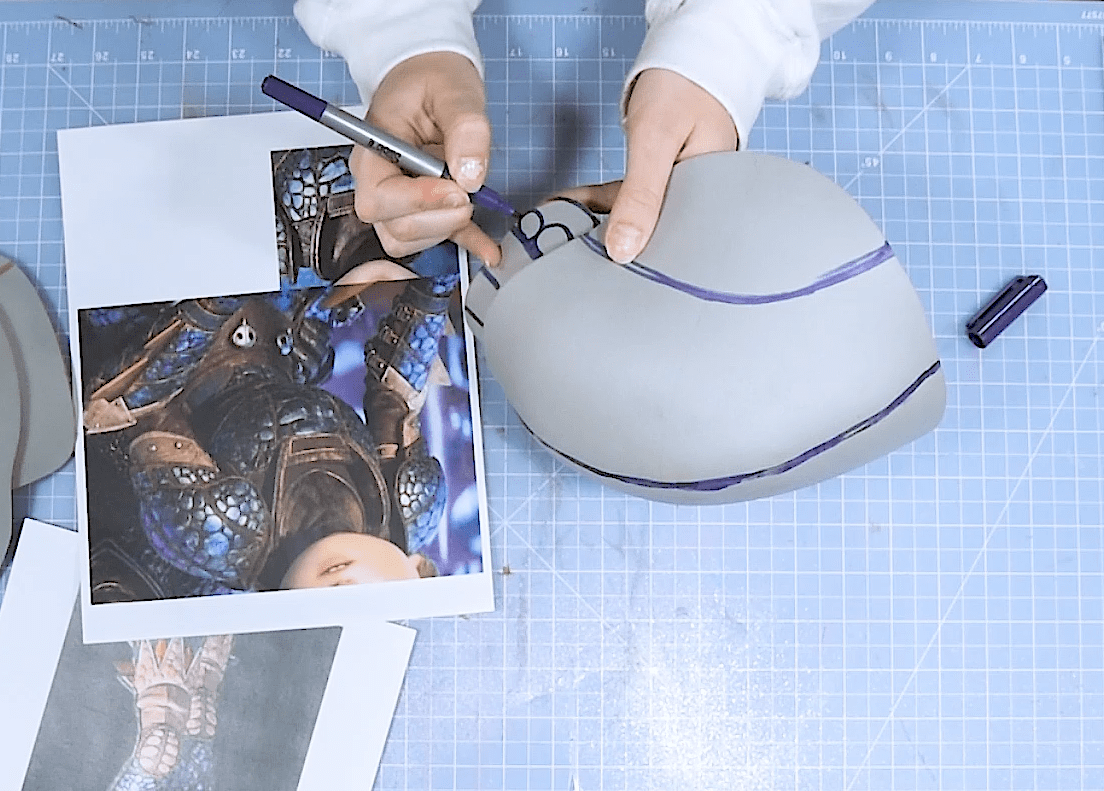Choosing the right material for your cosplay is one of the most vital steps during the planning stage of your build. Whether you’re a cosplay beginner or a more experienced creator, you’ve probably seen plenty of props and costumes made from EVA foam — a favorite material for many cosplayers regardless of the characters they create. Ever wondered why EVA foam is so popular in the cosplay community or if EVA is right for you and your cosplays?
In this post, we’ll discuss why building cosplay with EVA foam can be a great option for a range of different characters as well as the benefits and challenges of working with this versatile material.
When to Use EVA Foam for Cosplay

EVA, if you’ve ever wondered, stands for ethylene-vinyl acetate. This means that the material is a polymer of ethylene and some percentage of vinyl acetate. EVA foam (also known as PEVA or sometimes colloquially as craft foam or just “foam mats”) is typically used in flooring, sports equipment, clothing, set design, and crafts. There are different types of EVA foam that you can get from craft stores, cosplay specialty shops, and even hardware stores that vary in terms of texture, thickness, and other various properties, but most EVA foam typically behaves the same way and serves the same purposes in cosplay.
The most common use for EVA foam in cosplay is for building armor. While cosplayers can use more advanced and accurate materials such as thermoplastic or metal to build armored suits or costume parts, they take a lot more skill to work with and can be pretty expensive. Foam, on the other hand, is a great alternative for armor because it can mimic the look of metal, plastic, fiberglass with a little paint and detailing. If you’re new to making armor, foam is certainly the easiest material to work with, but even experienced cosplayers just generally like the foam-smithing process and the finished result it creates.
Even if you’re not building a full suit of armor, EVA foam can also be a great choice for the more sculptural elements of your cosplay, such as belts, shoulder pieces/pauldrons, boots or shoes, and other accessories to your cosplay.
When it comes to props and weapons, especially ones that are large and would be especially heavy to carry around all day at a convention or event, EVA foam is a great material choice. The same goes for foam weapons as for foam armor: the ability to manipulate foam to mimic heavier materials is a huge plus in this case as well.
Finally, EVA foam is a great option for cosplays that require a helmet or headpiece. If you’re trying to stay away from store-bought pieces that look low quality or don’t fit your head perfectly, molding foam into a custom helmet or headpiece is a popular option.
The Benefits of Working with EVA Foam
So what makes EVA foam such a popular choice for armored cosplays and oversized weapons? Here are some of the most vital benefits of working with EVA:

- EVA foam is incredibly lightweight, making it easy to handle, comfortable to wear all day, and convenient to carry.
- EVA foam is also inexpensive and easy to find. You can buy foam from craft or cosplay retailers, but many cosplayers also choose to buy foam puzzle mats from hardware stores, which usually have a large stock and low prices. You can get a lot more EVA foam for the same price as a lot less thermoplastic or metal.
- EVA foam can be easily handled and manipulated in a variety of ways to achieve your desired finished look.

- For example, EVA can be molded into curves that fit your head or body perfectly using a heat gun. Once you apply heat and bend your foam, it will hold this shape when cooled.
- You can also paint EVA foam using spray paints or acrylics to achieve any look you want, from shiny metallic to dull and weathered. It doesn’t matter what color your foam is as long as you use enough layers of paint to cover it.
- EVA foam can be shaped and carved in multiple ways depending on your preferences. You can use box cutters, heated soldering irons, or other implements to shape, weather, and detail your foam.
- When you’re building with EVA, you have a lot of options as far as adhesives go. Depending on the application or how strongly you need your pieces to bond, you can use contact cement, hot glue, double sided adhesive sheets, and more.
- If you need a thicker foam than what you can find at the store or online, you can layer pieces of foam using contact cement to make thicker sheets.
EVA Foam Cosplay Challenges
Of course, working with EVA foam also comes with a unique set of challenges. While these road blocks can be overcome with a little practice, here’s what you can expect when you’re working with EVA:

- In general, though foam is much easier to work with than heavier materials, it can take a greater deal of prep before and between steps in your process to get it ready for what’s next.
- Some EVA foams, especially those made as flooring mats, have textured surfaces you’ll need to smooth out for a flat surface. Using sandpaper, a belt sander, or a Dremel, you’ll need to buff off those rough textures before assembling and painting your armor.
- Additionally, you’ll need to seal your foam with a rubberized, flexible sealant (like wood glue or Plasti-Dip) before painting it to avoid cracking.
- If you’re in the market for higher density foam, which you’d likely buy from a cosplay-specific retailer, the price will be a little higher.
- While foam isn’t incredibly delicate, it’s also not incredibly durable either. Pieces can crack off if you bump into something/someone, or seams can come apart in areas that need to bend or that are often in motion. You do have to be a little bit more careful about how you move in foam armor.
- This also causes issues when transporting or shipping foam armor or weapons. The best strategy might be to design your pieces so that they can break down into smaller sections for easier, flatter packing that will help protect your foam in transit.
EVA Foam: the Go-To Cosplay Material
All around, EVA foam’s benefits tend to outweigh its disadvantages for the vast majority of cosplayers. Most have found easy workarounds that circumvent or minimize the challenges we’ve described — these are just accepted parts of working with foam that are totally worth it in hindsight. EVA foam can be molded and painted into incredibly detailed shapes, textures, and finishes that look almost exactly like the real thing. Combined with how widely available EVA foam is, it should be pretty easy to see why cosplayers of all kinda love working with EVA.